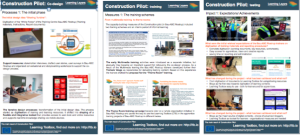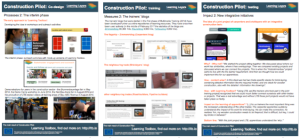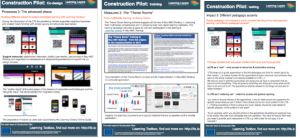In my previous post I started writing about the legacy of our recently completed EU-project Learning Layers and its Construction pilot. With this post I completed on our behalf the homework given by the reviewers of the project to produce a more compressed summary that gives an overview what was tried, achieved and learned in project work. After finishing this overarching 'legacy document' I needed to take a more specific look at our achievements in joint project activities with the construction sector training centre Bau-ABC Rostrup. It appeared that our 'Impact Cases' on the web were short of the summaries on "Main Impact". Now that I have completed these texts I found that they should also be presented as a more detailed account of the project work in, with and for a central application partner organisation.
Use of Learning Toolbox (LTB) by Bau-ABC Trainers and Apprentices
The Learning Toolbox grew out of the co-design process of an earlier prototype called Sharing Turbine. The initial design idea was based on the digitisation of training and learning resources for apprentice projects during their initial training. This design idea evolved during the co-design process into an integrated toolset to provide access to tools and web resources and supports real-time knowledge sharing via mobile devices.
The Learning Toolbox was then developed as an integrative toolset (mobile app container and toolkit) to support learning in the context of work. It was piloted firstly in the North German training centre Bau-ABC Rostrup to support apprentice training in the construction sector. The piloting was based on stacks created by Bau-ABC trainers for short training projects in their trades (carpentry, bricklaying, well-building, metalworking, pipeline-building). The main impacts of the pilots were the following:
- The trainers could shape their training project in a more flexible way. Some trainers developed joint projects for neighbouring trades (to highlight working interfaces). Some developed stacks with common patterns for parallel trades.
- The trainers could make more prominent use of trade-specific online resources (e.g. their own trade-specific blogs).
- The trainers could set their own accents for promoting self-organised learning among the apprentices. Some trainers emphasised problem-solving with a wide range of web resources to be searched. Others emphasised interest- and achievement-based expansion of resources that were made available in the course of learning process.
A more detailed picture of the pedagogic accents in the apprentice training is given in the Scenario document“Learning Toolbox (LTB) as Support for Action-Oriented Learning in the Apprentice Training of Bau-ABC - Instances of Change”.
Multimedia Training for and with Bau-ABC trainers
In the Learning Layers Construction pilot the project organised two Multimedia Training schemes for the training staff of the North German training centre Bau-ABC Rostrup. The first scheme was a generic Multimedia Training to support the trainers’ capability to create their trade-specific digital training and learning environments. The second scheme (the Theme Room Training) was initiated by the trainers to support wider use of digital media and web resources (and of Learning Toolbox) in Bau-ABC. The main impacts of the training schemes were the following:
- As a main result of the first Multimedia training scheme the participating core group of Bau-ABC trainers created their trade-specific blogs (Zimmererblog, Maurerblog, Tiefbaublog, Brunnenbauerblog) that they used as repositories for digital training materials.
- In the preparation of the Theme Room training the members of the core group developed themselves as peer tutors and multimedia trainers for construction sector professionals.
- In the Theme Room training all Bau-ABC trainers developed their capability to use social media, digital learning contents and digital learning tools.
- In the transition to piloting with the Learning Toolbox the members of the core group made focused use of digital learning tools (e.g. GoConqr) in their trade-specific stacks.
A more detailed insight into the Multimedia Training schemes is provided by the Methodology document “Training Interventions as Capacity-Building for Digital Transformation in Vocational Education and Training”.
- - -
I think that these short summaries (with pictures) give an overview what we achieved together in our project activities in the construction sector training centre Bau-ABC Rostrup. Based on this legacy we can work with further initiatives.
More blogs to come ...











